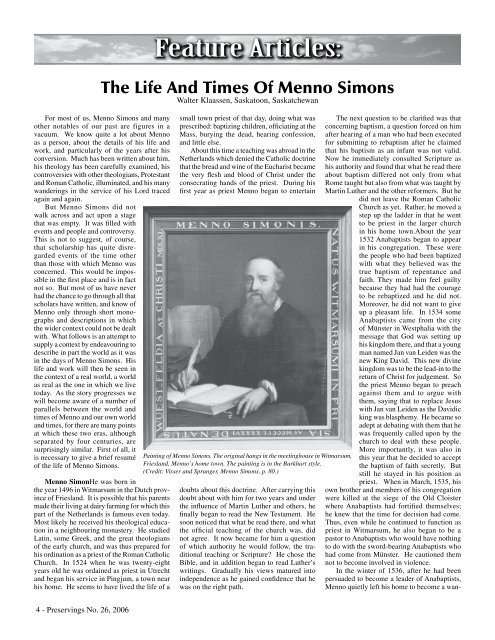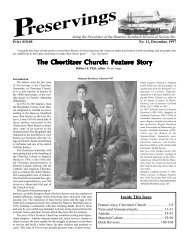Preservings $20 Issue No. 26, 2006 - Home at Plett Foundation
Preservings $20 Issue No. 26, 2006 - Home at Plett Foundation
Preservings $20 Issue No. 26, 2006 - Home at Plett Foundation
Create successful ePaper yourself
Turn your PDF publications into a flip-book with our unique Google optimized e-Paper software.
Fe<strong>at</strong>ure Articles:<br />
The Life And Times Of Menno Simons<br />
Walter Klaassen, Sask<strong>at</strong>oon, Sask<strong>at</strong>chewan<br />
For most of us, Menno Simons and many<br />
other notables of our past are figures in a<br />
vacuum. We know quite a lot about Menno<br />
as a person, about the details of his life and<br />
work, and particularly of the years after his<br />
conversion. Much has been written about him,<br />
his theology has been carefully examined, his<br />
controversies with other theologians, Protestant<br />
and Roman C<strong>at</strong>holic, illumin<strong>at</strong>ed, and his many<br />
wanderings in the service of his Lord traced<br />
again and again.<br />
But Menno Simons did not<br />
walk across and act upon a stage<br />
th<strong>at</strong> was empty. It was filled with<br />
events and people and controversy.<br />
This is not to suggest, of course,<br />
th<strong>at</strong> scholarship has quite disregarded<br />
events of the time other<br />
than those with which Menno was<br />
concerned. This would be impossible<br />
in the first place and is in fact<br />
not so. But most of us have never<br />
had the chance to go through all th<strong>at</strong><br />
scholars have written, and know of<br />
Menno only through short monographs<br />
and descriptions in which<br />
the wider context could not be dealt<br />
with. Wh<strong>at</strong> follows is an <strong>at</strong>tempt to<br />
supply a context by endeavouring to<br />
describe in part the world as it was<br />
in the days of Menno Simons. His<br />
life and work will then be seen in<br />
the context of a real world, a world<br />
as real as the one in which we live<br />
today. As the story progresses we<br />
will become aware of a number of<br />
parallels between the world and<br />
times of Menno and our own world<br />
and times, for there are many points<br />
<strong>at</strong> which these two eras, although<br />
separ<strong>at</strong>ed by four centuries, are<br />
surprisingly similar. First of all, it<br />
is necessary to give a brief resumé<br />
of the life of Menno Simons.<br />
Menno SimonHe was born in<br />
the year 1496 in Witmarsum in the Dutch province<br />
of Friesland. It is possible th<strong>at</strong> his parents<br />
made their living <strong>at</strong> dairy farming for which this<br />
part of the Netherlands is famous even today.<br />
Most likely he received his theological educ<strong>at</strong>ion<br />
in a neighbouring monastery. He studied<br />
L<strong>at</strong>in, some Greek, and the gre<strong>at</strong> theologians<br />
of the early church, and was thus prepared for<br />
his ordin<strong>at</strong>ion as a priest of the Roman C<strong>at</strong>holic<br />
Church. In 1524 when he was twenty-eight<br />
years old he was ordained as priest in Utrecht<br />
and began his service in Pingjum, a town near<br />
his home. He seems to have lived the life of a<br />
small town priest of th<strong>at</strong> day, doing wh<strong>at</strong> was<br />
prescribed: baptizing children, offici<strong>at</strong>ing <strong>at</strong> the<br />
Mass, burying the dead, hearing confession,<br />
and little else.<br />
About this time a teaching was abroad in the<br />
Netherlands which denied the C<strong>at</strong>holic doctrine<br />
th<strong>at</strong> the bread and wine of the Eucharist became<br />
the very flesh and blood of Christ under the<br />
consecr<strong>at</strong>ing hands of the priest. During his<br />
first year as priest Menno began to entertain<br />
Painting of Menno Simons. The original hangs in the meetinghouse in Witmarsum,<br />
Friesland, Menno’s home town. The painting is in the Burkhart style.<br />
(Credit: Visser and Sprunger, Menno Simons, p. 80.)<br />
doubts about this doctrine. After carrying this<br />
doubt about with him for two years and under<br />
the influence of Martin Luther and others, he<br />
finally began to read the New Testament. He<br />
soon noticed th<strong>at</strong> wh<strong>at</strong> he read there, and wh<strong>at</strong><br />
the official teaching of the church was, did<br />
not agree. It now became for him a question<br />
of which authority he would follow, the traditional<br />
teaching or Scripture? He chose the<br />
Bible, and in addition began to read Luther’s<br />
writings. Gradually his views m<strong>at</strong>ured into<br />
independence as he gained confidence th<strong>at</strong> he<br />
was on the right p<strong>at</strong>h.<br />
The next question to be clarified was th<strong>at</strong><br />
concerning baptism, a question forced on him<br />
after hearing of a man who had been executed<br />
for submitting to rebaptism after he claimed<br />
th<strong>at</strong> his baptism as an infant was not valid.<br />
<strong>No</strong>w he immedi<strong>at</strong>ely consulted Scripture as<br />
his authority and found th<strong>at</strong> wh<strong>at</strong> he read there<br />
about baptism differed not only from wh<strong>at</strong><br />
Rome taught but also from wh<strong>at</strong> was taught by<br />
Martin Luther and the other reformers. But he<br />
did not leave the Roman C<strong>at</strong>holic<br />
Church as yet. R<strong>at</strong>her, he moved a<br />
step up the ladder in th<strong>at</strong> he went<br />
to be priest in the larger church<br />
in his home town.About the year<br />
1532 Anabaptists began to appear<br />
in his congreg<strong>at</strong>ion. These were<br />
the people who had been baptized<br />
with wh<strong>at</strong> they believed was the<br />
true baptism of repentance and<br />
faith. They made him feel guilty<br />
because they had had the courage<br />
to be rebaptized and he did not.<br />
Moreover, he did not want to give<br />
up a pleasant life. In 1534 some<br />
Anabaptists came from the city<br />
of Münster in Westphalia with the<br />
message th<strong>at</strong> God was setting up<br />
his kingdom there, and th<strong>at</strong> a young<br />
man named Jan van Leiden was the<br />
new King David. This new divine<br />
kingdom was to be the lead-in to the<br />
return of Christ for judgement. So<br />
the priest Menno began to preach<br />
against them and to argue with<br />
them, saying th<strong>at</strong> to replace Jesus<br />
with Jan van Leiden as the Davidic<br />
king was blasphemy. He became so<br />
adept <strong>at</strong> deb<strong>at</strong>ing with them th<strong>at</strong> he<br />
was frequently called upon by the<br />
church to deal with these people.<br />
More importantly, it was also in<br />
this year th<strong>at</strong> he decided to accept<br />
the baptism of faith secretly. But<br />
still he stayed in his position as<br />
priest. When in March, 1535, his<br />
own brother and members of his congreg<strong>at</strong>ion<br />
were killed <strong>at</strong> the siege of the Old Cloister<br />
where Anabaptists had fortified themselves;<br />
he knew th<strong>at</strong> the time for decision had come.<br />
Thus, even while he continued to function as<br />
priest in Witmarsum, he also began to be a<br />
pastor to Anabaptists who would have nothing<br />
to do with the sword-bearing Anabaptists who<br />
had come from Münster. He cautioned them<br />
not to become involved in violence.<br />
In the winter of 1536, after he had been<br />
persuaded to become a leader of Anabaptists,<br />
Menno quietly left his home to become a wan-<br />
- <strong>Preservings</strong> <strong>No</strong>. <strong>26</strong>, <strong>2006</strong>
















